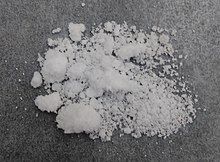Zirconium nitrate

| |
| Names | |
|---|---|
| Other names
zirconium tetranitrate, tetranitratozirconium, zirconium(4+) tetranitrate, zirconium(IV) nitrate
| |
| Identifiers | |
3D model (
JSmol ) |
|
| ChemSpider | |
ECHA InfoCard
|
100.033.917 |
PubChem CID
|
|
| UNII | |
CompTox Dashboard (EPA)
|
|
| |
| |
| Properties | |
| Zr(NO3)4 | |
| Molar mass | 339.243591 g/mol |
| Appearance | transparent plates |
| Melting point | °C |
| Boiling point | decompose 100 °C |
| water, ethanol | |
| Hazards | |
| Occupational safety and health (OHS/OSH): | |
Main hazards
|
oxidiser |
| Lethal dose or concentration (LD, LC): | |
LCLo (lowest published)
|
500 mg/m3 (rat, 30 min)[1] |
| Related compounds | |
Related compounds
|
titanium nitrate, zirconium perchlorate
|
Except where otherwise noted, data are given for materials in their standard state (at 25 °C [77 °F], 100 kPa).
| |
Zirconium nitrate is a volatile anhydrous transition metal nitrate salt of zirconium with formula Zr(NO3)4. It has alternate names of zirconium tetranitrate, or zirconium(IV) nitrate.
It has a UN number of UN 2728[2] and is class 5.1, meaning oxidising substance.[3]
Formation
The anhydrous salt can be made from
ZrCl4 + 4 N2O5 → Zr(NO3)4 + 4ClNO2
The product can be purified by sublimation in a vacuum. A contaminating substance in this is nitronium pentanitratozirconate. (NO2)Zr(NO3)5.[4]
Zirconium nitrate pentahydrate Zr(NO3)4·5H2O can be formed by dissolving zirconium dioxide in nitric acid and then evaporating the solution until it is dry. However it is easier to crystallise zirconyl nitrate trihydrate ZrO(NO3)2·3H2O from such a solution.[4]
Zirconium is highly resistant to nitric acid even in the presence of other impurities and high temperatures.[5] So zirconium nitrate is not made by dissolving zirconium metal in nitric acid.
Properties
Zirconium nitrate pentahydrate dissolves easily in water and alcohol. It is acidic in aqueous solution, and a base such as
Related substances
Related substances are zirconium nitrate complexes. Zr(NO3)3(H2O)+3 has a tricapped trigonal prismatic structure, with the nitrates connected by two oxygen atoms each (bidentate).[4] The pentanitrato complex Zr(NO3)−5 has all the nitrate groups bidentate, and has a bicapped square antiprism shape.[4]
NO2[Zr(NO3)3·3H2O]2(NO3)3 crystallizes in the
CsZr(NO3)5 crystallizes in the
(NH4)Zr(NO3)5·HNO3 crystallizes in the
A mixed
Use
Zirconium nitrate is manufactured by a number of chemical suppliers. It is used as a source of zirconium for other salts,
Zirconium free from hafnium is required for nuclear reactor construction. One way to achieve this is via a mixed aqueous solution of hafnium nitrate and zirconium nitrate, which can be separated by partitioning the zirconium into
Zirconium nitrate can be used as a Lewis acid catalyst in the formation of N-substituted pyrroles.[11]
Anhydrous zirconium nitrate can nitrate some organic aromatic compounds in an unusual way. Quinoline is nitrated to 3-nitroquinoline and 7-nitroquinoline. Pyridine is nitrated to 3-nitropyridine and 4-nitropyridine.[12]
References
- ^ "Zirconium compounds (as Zr)". Immediately Dangerous to Life or Health Concentrations (IDLH). National Institute for Occupational Safety and Health (NIOSH).
- ^ "App A". The Code of Federal Regulations of the United States of America. U.S. Government Printing Office. 1988. p. 254.
- ISBN 9789211391367.
- ^ S2CID 97703681.
- ^ Wah Chang (10 September 2003). "Zirconium in Nitric Acid Applications" (PDF). Retrieved 13 October 2014.
- ^ ISBN 0070494398.
- ISBN 9781566773195.
- ISSN 0897-4756.
- ISBN 9781420034141. Retrieved 17 October 2014.
- ^ Cox, R. P.; G. H. Beyer (23 December 1955). "Separation of Hafnium from Zirconium using Tributyl Phosphate". Retrieved 13 October 2014.
- ISSN 2046-2069. registration required
- ISBN 9780521233620. Retrieved 17 October 2014.
